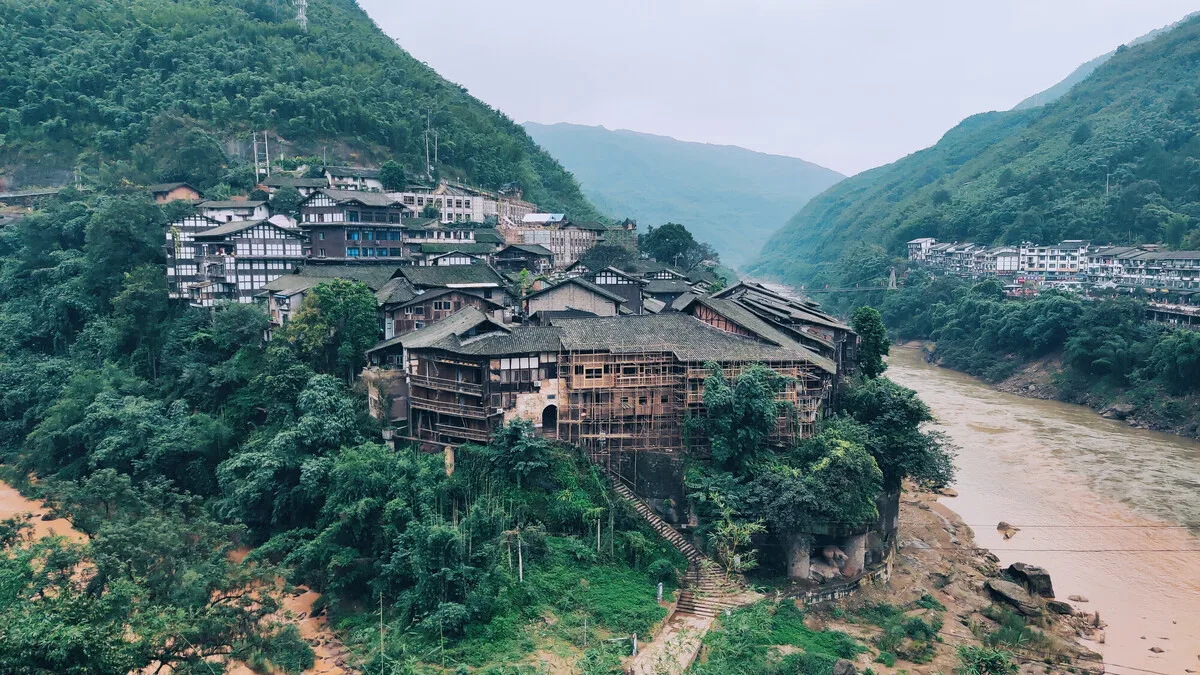Bing’an Ancient Town (丙安古镇), historically called Bingtan, derived its name from its location on the treacherous rapids of the midstream section of the Chishui River. With its quaint charm, it is one of the four major ancient towns in Guizhou Province. Bing’an Ancient Town is surrounded on three sides by the Chishui River, showcasing numerous stilted houses supported by hundreds of round wooden pillars along the riverbanks, presenting a spectacular sight. The town features only one narrow cobblestone street, approximately 400 meters long, which has long served as a vital trading hub for surrounding villages.
Since ancient times, Bing’an Ancient Town has been a famous post station for Sichuan salt entering Guizhou and a hub for commodity distribution. It serves as a crucial passage connecting various regions in Guizhou through the Chishui River, earning accolades from experts and scholars as a “living fossil of Ming and Qing architecture and history” and boasting the reputation of being a “millennium-old military and commercial ancient fortress.”
Table of Contents
- Basic Information
- Location and Transportation
- Highlights of Bing’an Ancient Town
- Vlog about Bing’an Ancient Town
- Attractions near Bing’an Ancient Town
Basic Information
| Estimated Length of Tour | 2 hours |
| Ticket Price | 10 RMB |
| Opening Hours | 8.30 – 17.30 |
| Telephone Number | 0086-0851-22991118 |
Location and Transportation
Bing’an Ancient Town is situated in the southern part of Chishui City, Zunyi, Guizhou Province, China, approximately 25 kilometers away from the city center of Chishui. Upon arriving in Chishui City, visitors can take Bus No. 3, Bus No. 6, or Bus No. 7, which are designated tourist buses for Chishui Danxia Scenic Area, and alight at the Bing’an Ancient Town (Bus Stop). From there, it’s just a short walk to reach the town.
Highlights of Bing’an Ancient Town
Cliff Stone Carvings

Dating back to the Republican era, the cliff stone carvings in Bing’an Ancient Town cover an area of approximately 2.4 square meters. Carved onto a large boulder standing 4 meters above the ground, these carvings are made of blue stone. The central part of the monument features four large running script characters, “惠及乡邻” (benefit the neighboring villagers), each measuring 0.45 meters in width and 0.55 meters in length. These characters commemorate the contributions of Wang Yuhui, a prominent figure who made significant contributions to the local community in the eleventh year of the Republic of China (1912).
Ancient Village Gates of Bing’an

The Bing’an Ancient Village Gates consist of the Donghua Gate and Taiping Gate, located respectively at the eastern and western ends of the Bing’an Township. Built during the Qing Dynasty, these gates cover an area of 25 square meters each and are constructed in an arched stone gate style. The Donghua Gate measures 3.1 meters in height, 2.2 meters in width, and 1.2 meters in thickness. It is equipped with two wooden doors for closing the gate, each door being 1.2 meters wide. The Taiping Gate stands at a height of 2.4 meters, with a width of 2.3 meters and a thickness of 1.5 meters. Descending westward from the gate, there is a stone staircase measuring 63 meters in total length, with each step being 1.7 meters long, 0.3 meters wide, and 0.15 meters high. On the right side of the staircase, there is a 0.7-meter-high stone railing, forming a staircase-like structure leading down to the ancient pier.
Red First Army Memorial Hall

The Red First Army Memorial Hall in Bing’an Ancient Town is one of the classic destinations for Red tourism in China. Following the Zunyi Conference in January 1935, the Central Military Commission decided to cross the Chishui River between Luxian County and Yibin County in Sichuan Province and move northward to resist the Japanese invasion. On January 24th, the Red First Army entered the territory of Chishui County and captured Yuanhouchang on the 25th, subsequently launching a two-pronged attack on Chishui County. Under the leadership of Li Jukui and Huang Su, the Red First Division advanced along the right bank of the Chishui River towards Guhu and Wanglong. Meanwhile, under the command of Chen Guang and Liu Yalou, the Red Second Division advanced from Yuanhouchang downstream, approximately 5 kilometers to Birong Ferry towards Bing’an and Fuxingchang. After occupying Bing’an, the Red Second Division set up its headquarters there. On the 26th, Lin Biao led the Red First Army Corps headquarters to Bing’an, establishing its command post in the residence of a landlord surnamed Wang. In the early hours of the 27th, the Red Second Division launched the Battle of Fuxingchang.
Huanxi Beach Stone Bridge

Located on the Huanxi Beach tributary in Aihua Village, Bing’an Township, the Huanxi Beach Stone Bridge was built in the 22nd year of the Guangxu reign (1896). The bridge, measuring 19.6 square meters, spans east to west and is constructed by jointing stone slabs. The bridge features four cylindrical stone piers supporting it, built from long-shaped stone slabs stacked to a height of 4 meters and a width of 2.3 meters. At the western end of the bridge, there is a stone niche statue of Guanyin, standing 2.3 meters tall and 0.9 meters wide, topped with a small eave.






The Bing’an Ancient Town in Chishui has not been overly commercialized; everything there feels quite original and authentic. The items are all old artifacts, making it a great place to visit.
Bing’an Ancient Town charges a ticket price of 10 yuan per person. There is a small parking lot on the left side of the ticket office; if it’s full, you can park along the side of the road. Exploring the ancient town takes about half an hour, and afterward, you can enjoy a cup of lid tea by the riverside for just 10 yuan. Sit back, feel the breeze, and enjoy the leisurely pace of life. Accommodation options are limited… Read more »
The ancient town of Chayan by the Chishui River features stunning cantilevered cliffside houses. However, the area is quite small.